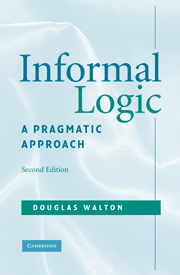Book contents
- Frontmatter
- Contents
- Preface
- Acknowledgments
- Informal Logic
- 1 Argument as reasoned dialogue
- 2 Questions and answers in dialogue
- 3 Criticisms of irrelevance
- 4 Appeals to emotion
- 5 Valid arguments
- 6 Personal attack in argumentation
- 7 Appeals to authority
- 8 Inductive errors, bias, and fallacies
- 9 Natural language argumentation
- Bibliography
- Index
2 - Questions and answers in dialogue
Published online by Cambridge University Press: 05 June 2012
- Frontmatter
- Contents
- Preface
- Acknowledgments
- Informal Logic
- 1 Argument as reasoned dialogue
- 2 Questions and answers in dialogue
- 3 Criticisms of irrelevance
- 4 Appeals to emotion
- 5 Valid arguments
- 6 Personal attack in argumentation
- 7 Appeals to authority
- 8 Inductive errors, bias, and fallacies
- 9 Natural language argumentation
- Bibliography
- Index
Summary
Normally in reasonable dialogue one is obliged to try to give a direct answer to a question, if one knows the answer, and if the question is reasonable and appropriate. If one does not know the direct answer, or for some reason cannot give it, then one is obliged to be as informative as possible. The reason behind this normal expectation is that our usual and reasonable presumption in many contexts is that a question is a sincere request for information where the questioner expects, or at least hopes, that the answerer may have this information and be able to give it. Therefore, if the answerer does not give a direct answer, his reply may be perceived as unhelpful or evasive.
Because of these normal expectations in reasonable dialogue, the most general purpose of a question is a request for information. Here, information refers to a set of propositions. So posing a question is a request to the answerer to supply a set of propositions.
There are several different types of questions each of which has a different format for requesting propositions. A whether-question poses a set of alternatives, and requests the answerer to select one. For example, the whether-question “Was she wearing the grey slacks or the red dress or blue jeans?” requests the answerer to pick one proposition from the disjunction. An example of a direct answer would be: “She was wearing the red dress.”
- Type
- Chapter
- Information
- Informal LogicA Pragmatic Approach, pp. 38 - 77Publisher: Cambridge University PressPrint publication year: 2008



